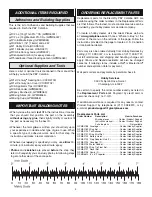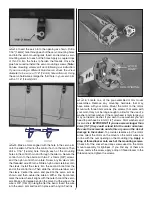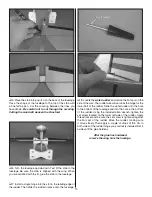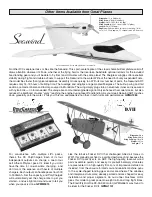
17
Note:
Do not rely upon the adhesive on the back of the lead
weight to permanently hold it in place. Over time the weight
could fall off. Use RTV silicone or epoxy to permanently hold
the weight in place.
❏
4.
IMPORTANT:
If you found it necessary to add any weight,
recheck the C.G. after the weight has been installed.
Balance the Model Laterally
❏
1. With the wing level, have an assistant help you lift the
model by the motor propeller shaft and the bottom of the
fuse under the TE of the fi n. Do this several times.
❏
2. If one wing always drops when you lift the model, it means
that side is heavy. Balance the airplane by adding weight
to the other wing tip.
An airplane that has been laterally
balanced will track better in loops and other maneuvers.
PREFLIGHT
Identify Your Model
No matter if you fl y at an AMA sanctioned R/C club site or
if you fl y somewhere on your own, you should always have
your name, address, telephone number and AMA number
on or inside your model. It is
required
at all AMA R/C club
fl ying sites and AMA sanctioned fl ying events. Fill out the
identifi cation tag on the bottom of this page and place it on or
inside your model.
Charge the Batteries
Follow the battery charging instructions that came with your
radio control system to charge the batteries. You should
always charge your transmitter and receiver batteries the night
before you go fl ying, and at other times as recommended by
the radio manufacturer.
Balance Propellers
Carefully balance your propeller
and spare propellers before you
fl y. An unbalanced prop can
be the single most signifi cant
cause of vibration that can
damage your model. Not only
will motor mounting screws
and bolts loosen, possibly with
disastrous effect, but vibration
may also damage your radio
receiver and battery. Vibration
can also cause your fuel to foam, which will, in turn, cause
your motor to run hot or quit.
We use a Top Flite Precision Magnetic Prop Balancer
(TOPQ5700) in the workshop and keep a Great Planes
Fingertip Prop Balancer (GPMQ5000) in our fl ight box.
Range Check
Ground check the operational range of your radio before the fi rst
fl ight of the day. With the transmitter antenna collapsed and the
receiver and transmitter on, you should be able to walk at least
100 feet away from the model and still have control. Have an
assistant stand by your model and, while you work the controls,
tell you what the control surfaces are doing. Repeat this test
with the motors running
at various speeds with an assistant
holding the model, using hand signals to show you what is
happening. If the control surfaces do not respond correctly,
do not fl y!
Find and correct the problem fi rst. Look for loose
servo connections or broken wires, corroded wires on old servo
connectors, poor solder joints in your battery pack or a defective
cell, or a damaged receiver crystal from a previous crash.
MOTOR SAFETY PRECAUTIONS
Failure to follow these safety precautions may result
in severe injury to yourself and others.
• Get help from an experienced pilot when learning to operate
electric motors.
• Use safety glasses when running electric motors.
• Do not operate the motor in an area of loose gravel or sand;
the propeller may throw such material in your face or eyes.
• Keep your face and body as well as all spectators away
from the plane of rotation of the propeller as you operate
the motor.
• Keep these items away from the prop: loose clothing, shirt
sleeves, ties, scarfs, long hair or loose objects such as
pencils or screwdrivers that may fall out of shirt or jacket
pockets into the prop.




































